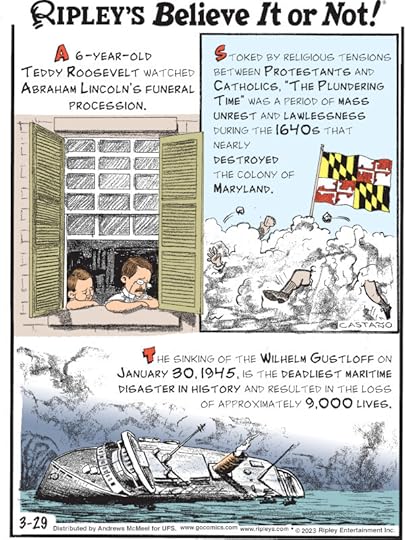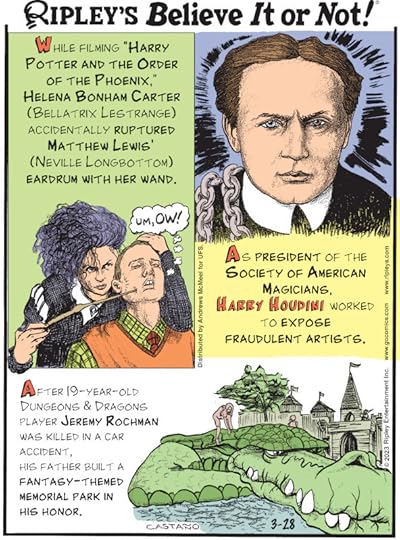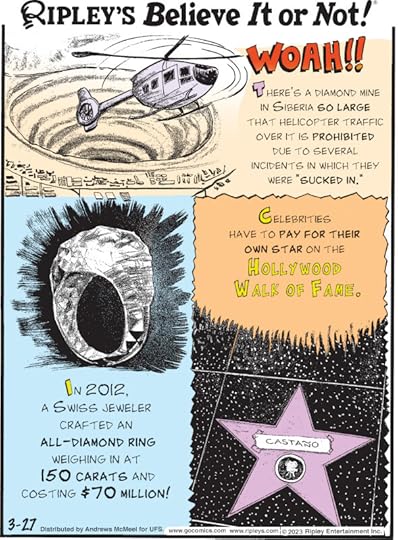Ripley Entertainment Inc.'s Blog, page 35
March 30, 2023
The ‘Rarest Chimpanzee On Earth’ Was Born At A Zoo In England
Featured in Ripley's Believe It or Not!

An infant chimp dubbed the “world’s rarest chimpanzee” by conservationists was born in Cheshire, England, in January!
Jeff (named after rock legend Jeff Beck), the west African chimp, is on the critically endangered list, according to the zoo’s website. Only 18,000 of the chimpanzees inhabit Africa, and the baby’s arrival will contribute to the species’ survival!
Champion ChimpThe healthy male chimp joined a group of 22 while bonding with his mother, ZeeZee, who is “doing a great job of cradling him closely and caring for him,” noted the zoo’s team manager Andrew Lenihan.
Deforestation in West Africa, illegal bushmeat hunting, and human diseases have adversely affected the chimp population. “He may not know it, but ZeeZee’s new baby is a small but vital boost to the global population of western chimpanzees, at a time when it’s most needed for this critically endangered species,” Lenihan noted.
Believe It or Not!, Western chimpanzees are extinct in Benin, Burkina Faso, and Togo, but small populations are still living in areas from Senegal to Ghana in West Africa.
No Monkeying AroundA staggering 80 percent of the western chimpanzee population has disappeared in the last 25 years, according to Mike Jordan, Chester Zoo’s animal and plant director. “The arrival of a healthy baby here at Chester offers us real hope that we can help turn things around for this species,” he said. “We’re in the midst of a global extinction crisis. The UN estimates that 1 million species could be wiped out in our lifetime.”
Chester Zoo is doing its best to reverse this trajectory by fostering an environment for the chimps to grow and thrive.
As for the infant chimp’s reception, the group has “a lot of excitement” from his extended family, according to Lenihan. “You’ll often see the new baby being passed between other females who want to lend a helping hand and give ZeeZee some well-deserved rest, and that’s exactly what her daughter, Stevie, is doing with her new brother. It looks as though she’s taken a real shine to him, which is great to see.”
The zoo spent time mulling over names for the infant chimp. Naming Jeff after a rock icon is a tradition at the facility. He will join fellow chimpanzees such as Dylan (Bob), Alice (Cooper), and Annie (Lennox). The animals are named after musicians to raise awareness for the species, reported The Mirror.
By Noelle Talmon, contributor for Ripleys.com
EXPLORE THE ODD IN PERSON! Discover hundreds of strange and unusual artifacts and get hands-on with unbelievable interactives when you visit a Ripley’s Odditorium!Source: The ‘Rarest Chimpanzee On Earth’ Was Born At A Zoo In England
CARTOON 03-30-2023
March 29, 2023
The War On Bagpipes: An Attempt To End The Instrument?
Featured in Ripley's Believe It or Not!

One of the most iconic and beloved moments in 1994’s Dumb and Dumber remains the “most annoying sound in the world” scene. Remarkably, the comedy bit was wholly improvised by Jim Carrey, delivering a high-pitched, nasally screech that’s pretty darn grating. Of course, different sounds affect people in unique ways. But some are considered universally awful. Think dripping faucets, buzzing flies, and alarm clock rings.
Research into the most annoying instrument sounds in the world reveals commonalities: piercing pitches, screeching sounds, squeakiness, and playing out of tune. Depending on the person, many instruments could fit this bill, including violins, clarinets, and flutes. But no instrument has faced as much abuse and opposition as bagpipes.
While some cling nostalgically to the sounds of this Highland instrument, others are far from charmed by its screeching strains. Here’s everything you need to know about the ongoing war on bagpipes.
The Battle of CullodenMany Americans think of bagpipes as synonymous with Scotland’s culture. One of the most popular events for tourists to the nation’s capital is Edinburgh’s Royal Military Tattoo. Annually, it draws approximately 200,000 attendees and gets broadcast to more than 100 million worldwide viewers. Of course, bagpipes figure prominently in the event, giving the impression that everyone is in love with this ancient instrument.

An Incident in the Rebellion of 1745′ by David Morier. Via Wikimedia Commons.
But dig a little deeper, and you’ll discover the pipes have faced a backlash for centuries, with the instrument’s most vehement enemies going for nothing less than urban eradication. It all started in 1746 in the aftermath of the Jacobites’ devastating losses at the Battle of Culloden. To make an example of those who rebelled against the Crown, the Brits picked a handful of Scottish Highlander rebels to stand trial in York.
A “Tool of Warfare”They included James Reid, a bagpipe player, who had accompanied troops into battle. Reid pled not guilty because he carried no weapons into battle. But this defense held no water with the Court of Exchequer, who declared Highland regiments “never marched without a piper, and, therefore, that in the eye of the law, [Reid’s] bagpipes were an instrument of war.”
With the musician’s supposed guilt confirmed, he got hung to death on November 15, 1746. Most historians agree this was the first time in history a musical instrument received such a title. But it would prove just the beginning of a war that still wages against the instrument.
The War on BagpipesWhat are some highlights in the so-called “War on Bagpipes?” They include the 1999 Campaign Against Bagpipes initiated by Clive Hibberts of Edinburgh. During this campaign, Hibberts and his friends targeted busking bagpipers along the Royal Mile. These efforts eventually failed, along with his attempt to nix kilts. Nevertheless, this strategic offensive against Scotland’s few remaining traces of original Highlander culture inspired future attempts to silence the pipes forever.

Kilted bagpiper performs on the street of the Royal Mile in Edinburgh, Scotland.
Nearly a decade later, in 2007, a second Campaign Against Bagpipes began, spearheaded by Andrew Jones and Ciaran Murtagh. Instead of declaring the instrument a weapon of war or an antiquated facet of Scottish culture that needed to go, Jones and Murtagh went straight for the jugular, proclaiming it an annoyance. Advocating for its removal from urban areas, they proposed setting up a sanctuary on the Isle of Skye for pipers to “play and dress as they please, far from civilization and annoyance.”
Eradicating Bagpipes from the Streets of EdinburghWithin a year, the War on Bagpipes gained enough momentum that Edinburgh threatened to jail any piper who performed along the Royal Mile. Their justification? City officials claimed law enforcement received upwards of 100 calls per day from disgruntled locals and shopkeepers tired of dealing with constant noise pollution. Three years later, the city passed legislation forbidding business owners from blaring bagpipe music via sidewalk speakers.
And in one of the most damning developments for the pipes, Rugby World Officials banned bagpipes from their events in 2011. The reason why? Not because of their historical weapon of war distinction or allegiance with certain political factions. But instead because they sound like “a hyena caught in a gin trap,” as sports broadcaster Miles Davis so eloquently put it. Clearly, there’s no love loss for the instrument, although we think it’d be a great addition to any future movies in the Dumb and Dumber franchise.
By Engrid Barnett, contributor for Ripleys.com
EXPLORE THE ODD IN PERSON! Discover hundreds of strange and unusual artifacts and get hands-on with unbelievable interactives when you visit a Ripley’s Odditorium!Source: The War On Bagpipes: An Attempt To End The Instrument?
CARTOON 03-29-2023
March 28, 2023
Meet the Cat-Fox: Adorable, Elusive, and Now Its Own Species
Featured in Ripley's Believe It or Not!

The fourth-largest island in the Mediterranean, Corsica sits off the southeast coast of France and west of the Italian Peninsula. It has a long history, including being the birthplace of Napoleon Bonaparte, and today, approximately 280,000 people call it home.
But the island’s cutest, and probably most mischievous, inhabitant is a rarely seen creature known locally as a “ghjattu volpe,” or “cat-fox.” Having long been a part of Corsica’s folklore, the cat-fox was only just recently discovered to be its own species.
Here’s everything you need to know about this marvelous critter, what sets it apart from other felines, and its potential origins.
Small But Mighty Cat-FoxesIt all started in a chicken coop. In 2008, a coop in the Corsican commune of Olcani inadvertently captured an animal that had remained elusive for centuries: the cat-fox. Corsican mythology had long discussed these furry rascals and their tangles with local shepherds. (Apparently, the felines had a nasty tendency to appear from the forest, ready to attack the udders of ewes and cattle.)
Fast forward to today, and there’s still much to learn about the cat-fox. Scientists have mostly relied on feline essence on wooden sticks to gather cat-fox fur for genetic testing. (The cats rub themselves on the sticks when they smell the scent, leaving their hair behind.)
From Cat-Fox Fur Samples to Live SpecimenWhat have researchers discovered by analyzing cat-fox fur and live specimen? Among their greatest discoveries has been the realization that cat-foxes are not related to the European wildcat. Instead, they are their own unique species specific to the French Mediterranean island! Believe It or Not!, through genetic analysis, scientists have “revealed a unique genetic strain to the wild cats.”
The elusive striped “cat-fox” familiar mostly to Corsican shepherds and as a source of intrigue to scientists, is indeed its own species specific to the French Mediterranean island, the French office for Biodiversity announced Thursday
➡️ https://t.co/Ji1O0kOdru pic.twitter.com/TrRQxDJabk
— AFP News Agency (@AFP) March 16, 2023
The French office for Biodiversity stated, “Genetic sampling clearly distinguishes the ring-tailed Corsican cat-foxes from mainland forest felines and domestic cats.” Scientists now have plenty of new insight behind the feline’s unique characteristics.
These include “highly developed” canine teeth, short whiskers, and “very wide” ears. They measure roughly 35 inches long from tail to head, and they have a distinctive ringed tail with two to four rings and a black tip. They boast a silky and dense coat that naturally deters lice, fleas, and ticks. And cat-foxes have “very dark” hind legs, stripes on their front legs, and a reddish-brown tummy.
Solving the Mystery of Cat-Fox OriginsBut why the clandestine presence? Because it helps the feline avoid its number one natural predator on the island: the golden eagle.
Embed from Getty Imageswindow.gie=window.gie||function(c){(gie.q=gie.q||[]).push(c)};gie(function(){gie.widgets.load({id:'LGRtaaEKS81iGGLizdNjjQ',sig:'_2bcULlzaEdSKjfeeFQhsWZF-aWWHA_cKFhHl7k9Q7Y=',w:'594px',h:'396px',items:'1149672391',caption: false ,tld:'com',is360: false })});Yes, you read that right! On Corsica, the birds hunt the cats — although we can assume it goes the other way with smaller feathered friends. (After all, the first live specimen turned up in a chicken coop, and it was there for more than the view.) Fortunately, the remote habitat the cat-fox prefers on Corsica is covered in plants and water, providing plenty of protection from raptors.
Since 2016, the ONCFS has trapped 12 of 16 island felines. During examinations before re-release, scientists have gathered plenty of data and now that the cat is recognized as a new species, scientists hope to keep the feline protected.
By Engrid Barnett, contributor for Ripleys.com
EXPLORE THE ODD IN PERSON! Discover hundreds of strange and unusual artifacts and get hands-on with unbelievable interactives when you visit a Ripley’s Odditorium!Source: Meet the Cat-Fox: Adorable, Elusive, and Now Its Own Species
CARTOON 03-28-2023
March 27, 2023
CARTOON 03-27-2023
March 26, 2023
CARTOON 03-26-2023
March 25, 2023
CARTOON 03-25-2023
March 24, 2023
Was Paul McCartney Replaced in 1966?
Featured in Ripley's Believe It or Not!

Today, we are jumping into a yellow submarine and going all the way back to November 9th, 1966, the day Paul McCartney died–or at least, that’s what conspirators will have you believe. We’re going to take a closer look at one of the biggest conspiracies in music history and break down some of the core elements to finally put to rest whether Paul McCartney is alive or if the man we know, and love is just a lookalike.
Music’s Biggest ConspiracySo how did this conspiracy come about? It started on October 12, 1969, while Russ Gibb, a Detroit DJ, hosting his radio show was asked by a caller to play The Beatles (White Album) and spin the intro from “Revolution 9” backwards. When Gibb tried it on the air, he heard the words, “Turn me on, dead man.” This revelation was all Beatles fans needed to scrub for any other “secret” messages throughout their discography.
Other messages were soon discovered while listening closely and adjusting the speed of song playback. For example, at the end of “Strawberry Fields Forever,” John can be heard saying what conspirators believe is “I buried Paul.”
Now that you know how the ball got rolling, let me lay out the conspiracy of Paul’s death and jump into the connections fans have made to support the claim through the music and artwork.
Here’s how the conspiracy went, Paul died on November 9, 1966. He drove away from Abbey Road late at night and ended up wrecking his car and never making it home. He was officially pronounced dead (“O.P.D.”) on Wednesday morning at 5 o’clock. The other Beatles decided to keep the news private, so papers did not report the accident. The band moved forward and kept Paul’s death a secret by replacing him with a look-alike.
The Fan’s FindingsSo how does any of this play into the Beatles lore? Here is what fans have found, starting with Sgt. Pepper’s Lonely Hearts Club Band, the 1967 studio album. On the front cover of the album fans noticed the funeral esq stylization of the flowers with the band and onlookers standing almost in memorial. The most prominent discovery came when a fan decided to hold a mirror up just under the three main members of the band. The writing on the kick drum spells out what appears to be a secret message: “IONEIX HE<>DIE” read as “11/9 he die” with an arrow pointing directly to Paul.
Fans found even more to justify their conspiracy on the back cover of the album. For one, Paul is the only Beatle with his back turned. Secondly, In the same photo, George stares downwards and points his finger to a specific lyric: “Wednesday morning at 5 o’clock as the day begins” the time conspirators believe Paul to be in the accident. On the gatefold of the album, Paul is seen wearing a badge that looks as though it spells O.P.D. Fans believed the acronym meant “Officially Pronounced Dead.”

On their following studio album, The Beatles (The White Album) there are also other “clues” fans spotted. Similar to the strange phrases fans discovered when playing “Revolution 9” backwards there was also a portion that revealed itself when played backwards on the song “I’m So Tired.” The ending of the song has John muttering what seems to be gibberish but when reversed says: “Paul is a dead man, miss him, miss him, miss him.”
The Beatles following album, Abbey Road, had fans pouring over the contents of the artwork. The Michigan Daily likened the Abbey Road cover as a funeral procession: the Preacher being John in all white, the Undertaker being Ringo in black, the Corpse being Paul’s lookalike, and finally George, in blue denim as the gravedigger.
The LookalikeSo, let’s get all this straight, if Paul died in 1966, who is the Paul McCartney we have seen nearly every year since? The answer conspirators have provided is a lookalike. Known by fans as “Faul” is rumored to be a Canadian man named William Shears Campbell.
The idea is that Campbell underwent various plastic surgery procedures to closer resemble Paul. Fans have gone as far to analyze Paul’s facial features throughout his career pointing out differences in his jawline and ears as proof that William Shears Campbell took over the role of Paul shortly after the accident.
Now, all this may sound convincing but let’s go through and debunk some of the biggest claims. For one, John was actually saying “cranberry sauce,” not “I buried Paul,” and the “O.P.D.” patch said “O.P.P.,” and believe it or not, was a gift from the Ontario Provincial Police.
Not to burst your bubble but Paul isn’t actually dead and really this conspiracy theory is most interesting because it depicts one of the first widespread cultural conspiracies. Although many now consider the theory to be more of a joke and sensational, at the time it was very widespread and even had The Beatles making public statements about the falsehoods.

During the tailspin of rumors surrounding Paul, Life magazine secretly sent reporters out to McCartney’s farm. In the November 9th cover story (“Paul McCartney Is Still With Us”), Paul added, “The Beatles thing is over.” Ultimately it was clouded by the all-consuming conspiracies around Paul’s death. In 2009, Paul stated “I think the worst thing that happened was that I could see people sort of looking at me more closely: ‘Were his ears always like that?’”
So, there you have it – from an early morning car accident to secret messages, to a lookalike who underwent plastic surgery. One of the most interesting less talked about facets of this conspiracy is that if the Paul lookalike was true that would mean he actually would end up writing some of Paul’s best material! Let me know in the comments below how you think this conspiracy shifted the cultural winds and widespread prominence of other major conspiracies. Until next time, I’m Jordan Neese, and this is Ripley’s Rewind.
EXPLORE THE ODD IN PERSON! Discover hundreds of strange and unusual artifacts and get hands-on with unbelievable interactives when you visit a Ripley’s Odditorium!Ripley Entertainment Inc.'s Blog
- Ripley Entertainment Inc.'s profile
- 52 followers









